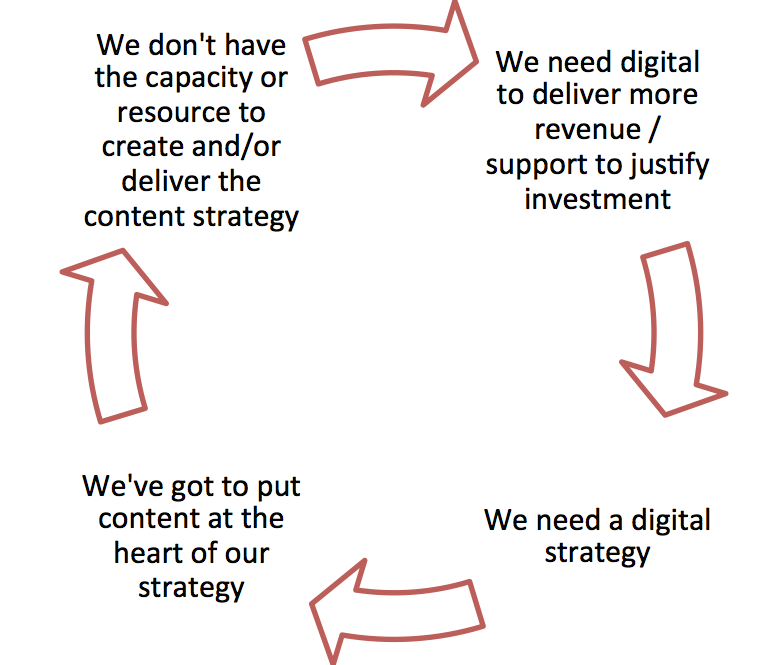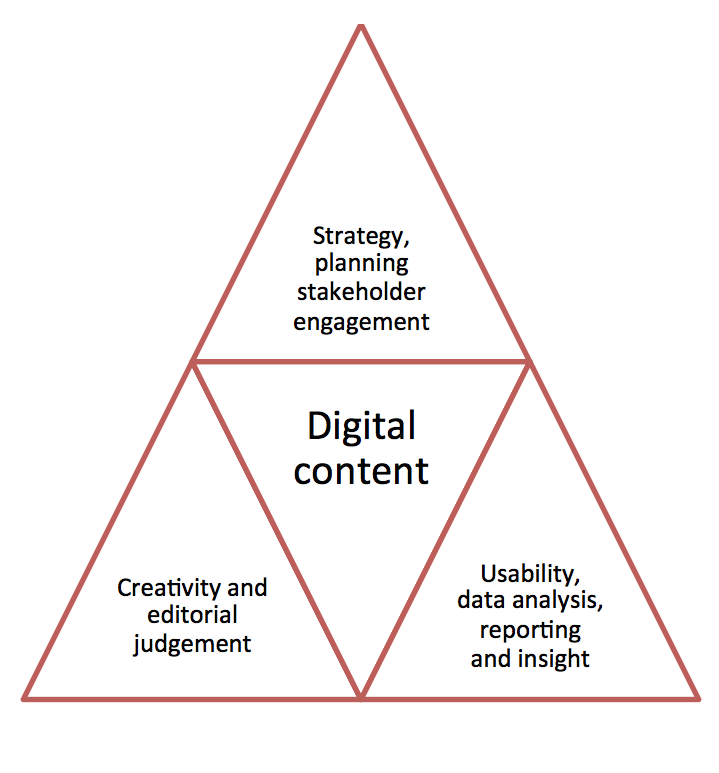I’ve been helping one of our clients to hire a content person recently and the process surfaced some interesting and familiar questions.
They go something like this …
What to call the job? Content manager or digital editor? Is it someone to upload and publish you need, or a buck-stops-here strategic planner?
How to pitch the job? ‘Hands on and creative’, ‘technical and data focused’ or ‘a strategic role playing a critical part in our transformation programme’?
What level to hire at? The motivated but untested junior who’s ready to step up, the safe pair of hands or the experienced senior player (who you can’t quite afford)?
And finally …
Who to hire? The writer/editor/video creative who has emailed you ten brilliant ideas before they’re even out of the shower? The techie genius who goes to sleep and dreams about GA tracking tags, data analysis and social media monitoring tools? The marketer who could sell coal to Newcastle? Or the project manager who couldn’t just organise a booze-up in a brewery – they could put the whole brewing process into a gantt chart?
The annoying part is that all of these things are equally important. For digital content to be truly effective it needs to be high quality and creatively brilliant, it needs to be delivered in the most user-friendly way, it needs to be developed with audience needs front and centre, for the web and beyond not just for your website, it needs to be planned and tracked and tweaked based on what the data says, it needs to be aligned with the organisation’s wider strategy, with a clear objective in mind, and it needs to happen on time and be produced in as efficient a way as possible.
As I said in a previous post, for a charity, content – the story of your work – is your product. Without the best content you won’t stand out and your fight to grab the attention of those who want to support good causes. So all of the above is even more critical.
Why is this annoying? Because it means content strategy and production isn’t a one-person job. But because of limited resources, lots of organisations are still working on the assumption that that it is. And this leads to a horrible chicken/egg situation:
Are you looking for a ‘content manager’ or a superhero?
If you’re working on the assumption that digital content is a one-person job you will find that the job spec and required skills for a ‘content person’ starts to look a little on the long side. You’ll also find that you scare off a high proportion of the best candidates (you won’t know this – because you’ll never hear from them, but trust me – you will). And when it comes to interviewing the ones who have applied you’re going to be comparing apples with oranges. It will be almost impossible to make a confident decision.
Once you’ve made your appointment you’ll have a new set of issues to deal with. Should your content person be focused on the day-to-day doing? Or on planning? Or on developing new formats and approaches? Or on monitoring and reporting back to everyone else? Or on managing stakeholder expectations and balancing their priorities?
Too often, the answer is: all of the above. So now the question is: what are you going to do when this person wants to take a holiday? Or gets ill? Or finds the pressure and long hours so intolerable they have a nervous breakdown?
An inconvenient truth
Planning and production of digital content is definitively not a one-person job. And in organisations that haven’t yet found a way to resource content properly that’s a tricky problem to solve.
Some organisations have approached the problem by ‘devolving digital’. The thinking goes: we don’t have the resource to have a content team – so we’ll ask existing teams to take on responsibility for producing content for their bit of the organisation. And this can work really well. But only if you have a clearly defined and widely understood digital content strategy driving the devolved production process.
The truly ‘transformed’ organisation understands this. It is a wise organisation that realises that just because content management systems enable content creation to be dispersed doesn’t necessarily mean it should be. The content lead must put in place tools (personas, tone of voice, planning and prioritisation processes) which enable disparate publishing teams to come together and the organisation to free itself from an ‘I exist therefore I publish’ mantra. This type of leadership role is a long way from a sub-editing/production role and requires different skills. And your organisation needs to be able to empower them. You can recruit really well, but if you don’t give your editor the freedom and authority to edit (not sub-edit) your website then you will subject them to a life of constantly difficult negotiations to improve your site which they can’t win.
And you still need people at the centre to own and enforce messaging and tone of voice, manage ongoing planning and prioritising, develop new approaches and innovations, ensure quality assurance and consistency, editing, publishing schedules, training devolved content producers, monitoring, data analysis and reporting. So it still isn’t a one-person job.
Great digital content comes from digital teams
No matter which way you come at the problem, digital content planning and production is a team effort covering a broad spectrum of responsibilities and skills:
It requires at least two people to cover all these responsibilities – one person to own planning, data-driven strategy and persuading the rest of the organisation to keep developing and investing time and money, one person to support production and implement the plan and report back on how it’s all working. If your digital plans involve thinking beyond your own website (and they must if you’re ever going to stand a chance of winning any attention) then you’re looking at a three person job, minimum.
If this all sounds horribly familiar and you’re not sure how to break the vicious circle, then perhaps get in touch? Let us help you develop the case you need to persuade your stakeholders to give you the people and the resources you need to create great digital content.


